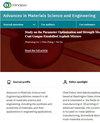锐钛矿掺杂赤铁矿纳米陶瓷体系的合成与表征
4区 材料科学
Q2 Engineering
引用次数: 5
摘要
通过机械化学活化,在x = 0.1和0.5条件下,球磨时间为2 ~ 12小时,得到了× tio2 -(1−x) α - fe2o3陶瓷纳米颗粒体系。采用x射线衍射(XRD)、穆斯堡尔能谱(Mossbauer)、透射电镜(TEM)结合电子衍射(ED)研究了锐钛矿掺杂赤铁矿体系的结构和形态特征。在x射线衍射图中,我们可以证明赤铁矿中锐钛矿的溶解,当x = 0.1时更明显。XRD谱图的Rietveld结构表明,颗粒尺寸和晶格常数与Ti取代量x和球磨时间有关。当x = 0.1时,我们观察到穆斯堡尔共振的谱线展宽,并与几个子谱对应拟合。当x = 0.5时,可以观察到超顺磁粒子对应的中心重态变得更加突出。球磨路线使我们能够达到纳米级颗粒尺寸,这将使材料在催化和气体传感应用中非常有前途。本文章由计算机程序翻译,如有差异,请以英文原文为准。
Synthesis and Characterization of Ceramic Nanoparticles System Based on Anatase-Doped Hematite
The x TiO 2 - ( 1 − x ) α - Fe 2 O 3 ceramic nanoparticles system has been obtained by
mechanochemical activation for x = 0.1 and 0.5 and
for ball milling times ranging from 2 to 12 hours.
Structural and morphological characteristics of the anatase-doped
hematite system were investigated by X-ray diffraction (XRD),
Mossbauer spectroscopy, and transmission electron microscopy
(TEM) combined with electron diffraction (ED). In the XRD
patterns, we could evidence the dissolution of anatase in
hematite, more pronounced for x = 0.1. The Rietveld
structure of the XRD patterns yielded the dependence of the
particle size and lattice constants on the amount x
of Ti substitutions and as function of the ball milling time. For
x = 0.1, we observed line broadening of the
Mossbauer resonances and corresponding fit with several
subspectra. For x = 0.5, it can be observed that the
central doublet corresponding to superparamagnetic particles
becomes more prominent. The ball milling route allowed us to reach
nanometric particle dimensions, which would make the materials
very promising for catalytic and gas sensing applications.
求助全文
通过发布文献求助,成功后即可免费获取论文全文。
去求助
来源期刊

Advances in Materials Science and Engineering
Materials Science-General Materials Science
CiteScore
3.30
自引率
0.00%
发文量
0
审稿时长
4-8 weeks
期刊介绍:
Advances in Materials Science and Engineering is a broad scope journal that publishes articles in all areas of materials science and engineering including, but not limited to:
-Chemistry and fundamental properties of matter
-Material synthesis, fabrication, manufacture, and processing
-Magnetic, electrical, thermal, and optical properties of materials
-Strength, durability, and mechanical behaviour of materials
-Consideration of materials in structural design, modelling, and engineering
-Green and renewable materials, and consideration of materials’ life cycles
-Materials in specialist applications (such as medicine, energy, aerospace, and nanotechnology)
 求助内容:
求助内容: 应助结果提醒方式:
应助结果提醒方式:


